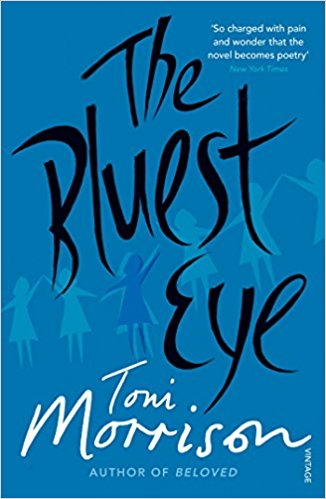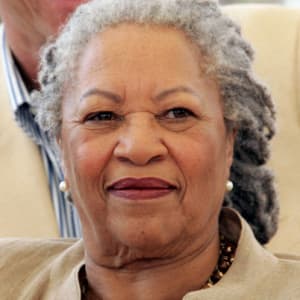The Bluest Eye
6 min read ⌚
 We don’t need to tell you anything more but the fact that today’s summary is a story about a black 10-year girl back in the 1940s to make you realize that you’ll need some tissues and a lot of strength to endure it.
We don’t need to tell you anything more but the fact that today’s summary is a story about a black 10-year girl back in the 1940s to make you realize that you’ll need some tissues and a lot of strength to endure it.
But, this time, it’s even worse than you can imagine.
So, prepare for a great deal of pain and even more suffering: It’s Toni Morrison’s “The Bluest Eye.”
Who Should Read “The Bluest Eye”? And Why?
We know some people who think that the story about white privilege and bias is a lie furthered by cultural Marxism.
In fact, we know millions of them.
If you ask us, there should be a law that they should read “The Bluest Eye” and repeat their beliefs once again after finishing it.
As for the others – read it because it’s a great, endlessly lyrical masterwork of literature.
Toni Morrison Biography
Toni Morrison is an American writer and Professor Emeritus at Princeton University.
is an American writer and Professor Emeritus at Princeton University.
She gained some popularity with “The Bluest Eye,” but “Song of Solomon” cemented her reputation as a great writer.
She won a Pulitzer Prize in 1988 for “Beloved,” a novel inspired by the life of African-American slave Margaret Garner who chose to kill her own daughter rather than allowing the U.S. government to take her back to slavery.
The book was turned into an Academy Award-nominated movie starring Oprah Winfrey a decade later.
In the meantime, Morrison won the Nobel Prize in Literature in 1993.
Book Summary
“The Bluest Eye” is a national bestseller, examining society’s obsession with beauty. As mentioned by the New York Times, in this book Morrison’s writing is “so precise, so faithful to speech and so charged with pain and wonder that the novel becomes poetry”
Our narrator (well, mostly) Claudia MacTeer is a mature, independent 9-year-old girl who lives with her one-year older sister Frieda and her parents in an “old, cold and green” house in Lorain, Ohio.
The family isn’t really wealthy but is kind and caring.
And, in the beginning of the book, they decide to take under their wing a tenant named Mr. Henry, and Pecola Breedlove, a temporary foster child who likes Shirley Temple.
Oh, yes – did we forget to mention?
It’s 1941 and Shirley Temple is 13 years old and a big thing – or as Salvador Dali would say, “the youngest, most sacred monster of the cinema in her time.”
Also, Pecola is black.
And comes from a family which is all but the opposite of the MacTeers.
In fact, the reason why she is there with Frieda and Claudia is as gruesome as it comes: her alcoholic and abusive father Cholly had burned down their house.
Needless to add, Pecola didn’t have a great childhood.
She spent most of it alone and quiet, wishing that her parents would stop fighting (both verbally, and, unfortunately, literally as well).
And as it often happens, in time, she started blaming herself for her parents’ problems. Being a child – and one constantly reminded by absolutely everybody that she is “ugly” – Pecola starts believing that her parents may be better to each other if she was a little bit more beautiful.
And, to Pecola in 1941, being more beautiful meant the same thing it did to Michael Jackson half a century later: being whiter.
And also – what it did to Hitler about the same time on the other side of the Atlantic:
Namely, having blue eyes!
Just like all those beautiful white children in the “Dick and Jane” series of books, just like all those blue-eyed dolls she had received throughout her childhood!
But Pecola’s parents, Cholly and Pauline, didn’t get to become the way they were just because they wanted to.
There’s a whole history there too.
And, unfortunately, most of it you can already guess.
But, since, it’s really something you should never forget – It’s flashback time nevertheless.
So, Pauline Breedlove had a deformed foot and felt as an outcast in her large family. She was also an outcast in the white Anglo-Saxon Protestant community around and an outcast in her own community as well, in face of her views on love and marriage.
So, basically, quite the same as Pecola herself, only a decade later.
Speaking of which – Pauline had a role model as well, and once again we’re talking about a white actress:
Jean Harlow, Ms. Blond Bombshell herself.
Of course she ended up marrying someone who was quite the opposite of what she dreamed a romantic partner is.
Cholly Breedlove.
He and Life got off on an even “wronger foot”: Cholly was left near the train tracks when he was just four days old.
Fortunately, his great aunt Jimmy takes care of him; unfortunately, the day she dies is the day he experiences a humiliation which will leave a scar on much stronger men than him.
Namely, as he has sex for the first time with a girl named Darlene, two white men flash them and force them to continue making love while they are watching them.
How much more can a man take?
Unfortunately, there’s a lot more where that came from.
And it pains us to even retell it.
Because back in the present, as she is one day doing the dishes, Cholly rapes her daughter Pecola.
Don’t ask us why.
We don’t know. Nobody knows, in fact.
We’re quite sure that even Cholly doesn’t.
Which makes for an even more painful reading the second time it happens. Especially since this time, it leads to Pecola being pregnant.
And it gets even worse from there on…
The Bluest Eye Epilogue
Claudia and Frieda find out about Pecola’s pregnancy and, unlike everybody else around, pray that it survives.
And since they are children – and it’s the 1940s – they believe that if they plant marigold seeds and the flowers eventually bloom, Pecola’s baby will survive.
So, they use all the money they had saved to buy a bike to buy marigold seeds.
The flowers never bloom.
And since this is literature and symbols mean something, Pecola’s prematurely born baby dies.
But it’s still not the end.
You see, in the meantime, Pecola, superstitious herself, goes to Soaphead Church, self-titled “Reader, Adviser, and Interpreter of Dreams” but also a misanthrope and a quack healer.
Pecola asks from his blue eyes.
He says that she will get them if she gives some food to his landlord’s dog and if the dog reacts in some way.
The dog does alright – but only because the food Soaphead Church gives Pecola to feed the dog with is previously poisoned by him.
Pecola believes that she will get her blue eyes.
Instead, she goes mad.
She starts talking to herself and we realize that she doesn’t know how to react to her father raping her, but she does know that she already has gotten her blue eyes.
After all, she thinks, everybody has started looking at her differently.
It must be the blue eyes.
It couldn’t be the incest or the rape, the pregnancy or the fact that she’s insane, could it?
My god, there’s so much pain and suffering here.
Like this summary? We’d like to invite you to download our free 12 min app, for more amazing summaries and audiobooks.
“The Bluest Eye Summary Quotes”
Beauty was not simply something to behold; it was something one could do. Share on X Love is never any better than the lover. Wicked people love wickedly, violent people love violently, weak people love weakly, stupid people love stupidly, but the love a free man is never safe. Share on X And the lives of these old black women were synthesized in their eyes- a puree of tragedy and humor, wickedness and serenity, truth and fantasy. Share on X This soil is bad for certain kinds of flowers. Certain seeds it will not nurture, certain fruit it will not bear, and when the land kills of its own volition, we acquiesce and say the victim had no right to live. Share on X Their conversation is like a gently wicked dance: sound meets sound, curtsies, shimmies, and retires. Another sound enters but is upstaged by another: the two circle each other and stop. Share on XOur Critical Review
“The Bluest Eye” – as one review has concluded – is “so charged with pain and wonder that the novel becomes poetry.”
Described as “a series of painfully accurate impressions,” the book has been challenged more times than “The Giver” and praised as much as “Beloved,” Morrison’s most celebrated book.
There were reasons for the former when the novel first appeared in 1970 – but time has vindicated “The Bluest Eye” and proved wrong the ones challenging it.
Which means – there will always be reasons for the latter.
Emir is the Head of Marketing at 12min. In his spare time, he loves to meditate and play soccer.







